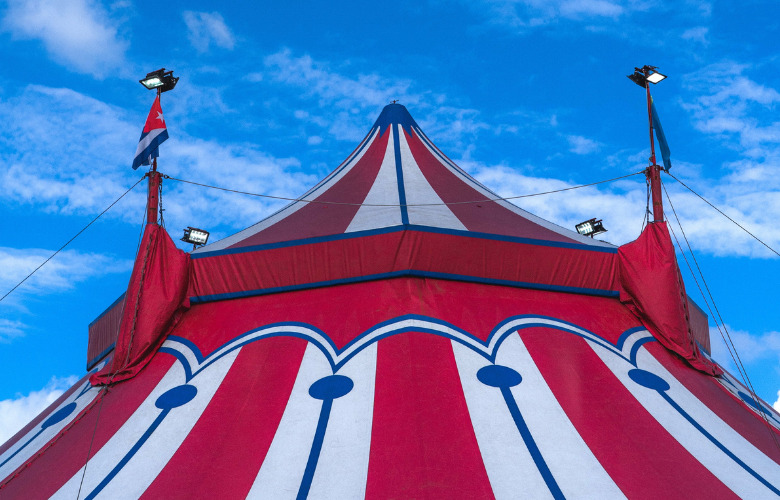
The origin of modern circus has been attributed to Philip Astley. He was an Englishman and former cavalry Sergeant-Major turned showman who set up the first modern amphitheatre for the display of horse-riding tricks in Lambeth, London, on 4 April 1768. Astley did not invent trick horse riding. Nor was he the first to introduce acts such as acrobats and clowns to the English public. But he was the first individual to create a space where all these acts were brought together to perform a show.
Being an idealistic young man, Astley signed up for the army at a young age. He then served in the Seven Years’ War (1756-63) as part of Colonel Elliott’s 15th Light Dragons regiment.
It was there, he was first noticed for displaying a remarkable talent as a horse-breaker and trainer.
After his honourable discharge from the army, Astley stayed true to his primary passion: horses.
He was fascinated with trick-riders who were becoming ever more popular as performers all over Europe.
Jacob Bates, an English equestrian based in the German States, who performed as far away as Russia (1764-65) and America (1772-73), was the first of these showmen to make a mark.
In 1768, Astley settled in London and opened a riding-school near Westminster Bridge. There he gave lessons to young horsemen in the morning. In the afternoons, however, he performed his “feats of horsemanship.”
At this time, modern commercial theatre (a word that encompassed all sorts of performing arts) was in the process of developing in London. Astley’s acrobatic performances featuring horses fit right in.
However, the circus ring was not Astley’s invention. Performing trick-riders had already introduced this kind of space to audiences before his time.
The set-up allowed audiences to always keep sight of the riders during their performances.
Riding in circles in a ring also made it possible, through the generation of centrifugal force, for riders to keep their balance while standing on the back of galloping horses.
Astley’s original ring was about sixty-two feet in diameter. Its size was eventually settled at a diameter of forty-two feet, which has since become the international standard for all circus rings.
By 1770, Philip Astley had become incredibly successful as an equestrian performer. But, to keep audiences interested, he needed to add to the repertoire of his performances. Thus, he began to hire acrobats, ropedancers, and jugglers. To intersperse their acts between his equestrian displays.
He also borrowed an idea from Elizabethan theatre – the clown – a character who filled the pauses between acts with burlesques of juggling, tumbling, rope-dancing, and even trick-riding.
As we mentioned in our introduction already, Astley hadn’t invented any of the elements of his shows as such. But he was the first showman to combine all these elements: equestrian performances with acrobatics, choreography, and clowns in a ring.
In 1782, Philip Astley opened Paris’s first circus, the Amphithéâtre Anglois.
That same year, his first competitor entered the stage, so to speak: equestrian Charles Hughes (1747-97). He was a former member of Astley’s company.
Hughes opened a rival amphitheatre and riding-school in London, in association with Charles Dibdin, a songwriter and author of pantomimes. The company was called The Royal Circus and Equestrian Philharmonic Academy.
The first element of this rather grandiose title was to be adopted as a generic name for the new form of entertainment, the circus.
In 1793, Hughes went to perform to the court of Catherine the Great in St. Petersburg, Russia.
That same year, one of his students, British equestrian John Bill Ricketts (1769-1802), opened the first circus in the United States, in Philadelphia.
In 1797, Ricketts also established the first Canadian circus, in Montréal.
His only competition in America, the British equestrian Philip Lailson (who came to the U.S. in 1795), brought the circus to Mexico in 1802.
Over time, circus performances moved from amphitheatres inside buildings. At first, these were usually simple, temporary, wooden structures.
From 1800 onwards, resident circus companies settled in every major European city. Soon after as well in the New World. In New York, Philadelphia, Montréal, Mexico City, etc.
Forthwith, circus venues were also built on a more permanent basis. Soon, they could compete in design and grandeur with some of the traditional theatre venues. All palaces of performance in their own right.
Buildings remained the choice setting for circus performances in Europe well into the twentieth century. However, in the United States the circus arts developed into a traveling entertainment business over time.
Soon, this concept was embraced by European circus companies as well.
Way back in his time, he already understood the importance of acrobatic performances. He understood that circus, with all the elements he combined on stage, is a visual performing art which is timeless in its physical beauty.
Circus is a universal language which can be felt and understood by everyone.
And, as such, this performance art can bring joy and laughter to every corner of the world. There are no language barriers. No social barriers. And no age barriers. Circus is open to all.
Sources for this article:
‘Short History of the Circus’, by Dominique Jando, on Circopedia
‘What Was The First Circus’, by Laurie L. Dove on howstuffworks
‘Circus’ on Wikipedia
Keep Your Cool Backstage as a Stage Manager: 12 Insights
The House of Dancing Water… Remembering a Masterpiece


Liam Klenk was born in Central Europe and has since lived on four continents. Liam has always been engaged in creative pursuits, ranging from photography and graphic design, to writing short stories and poetry, to working in theatre and shows. In 2016, Liam published his first book and memoir, 'Paralian'.
Read Full Profile© 2021 TheatreArtLife. All rights reserved.

Thank you so much for reading, but you have now reached your free article limit for this month.
Our contributors are currently writing more articles for you to enjoy.
To keep reading, all you have to do is become a subscriber and then you can read unlimited articles anytime.
Your investment will help us continue to ignite connections across the globe in live entertainment and build this community for industry professionals.